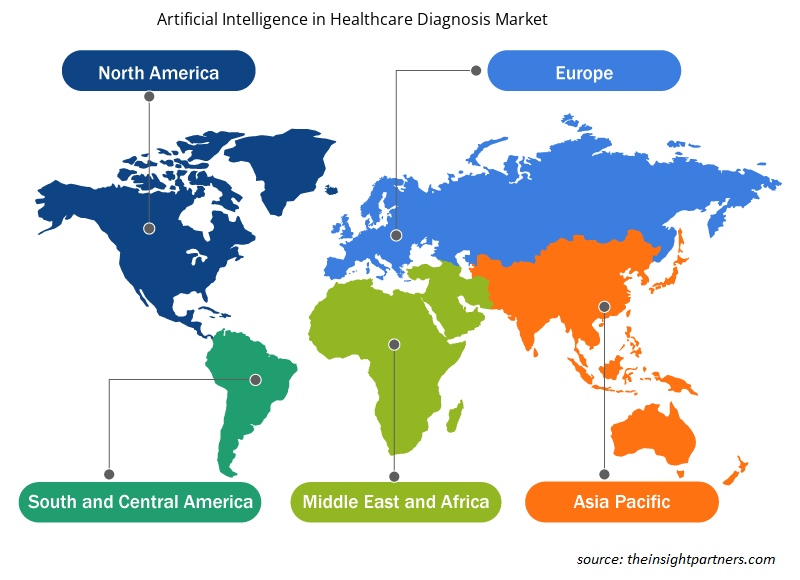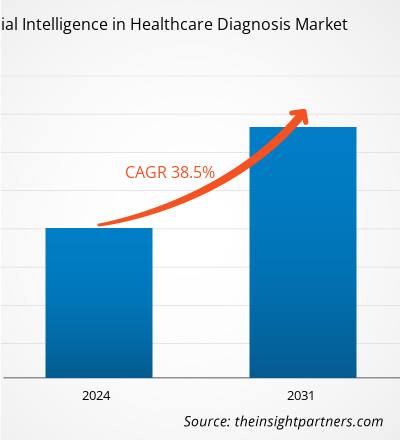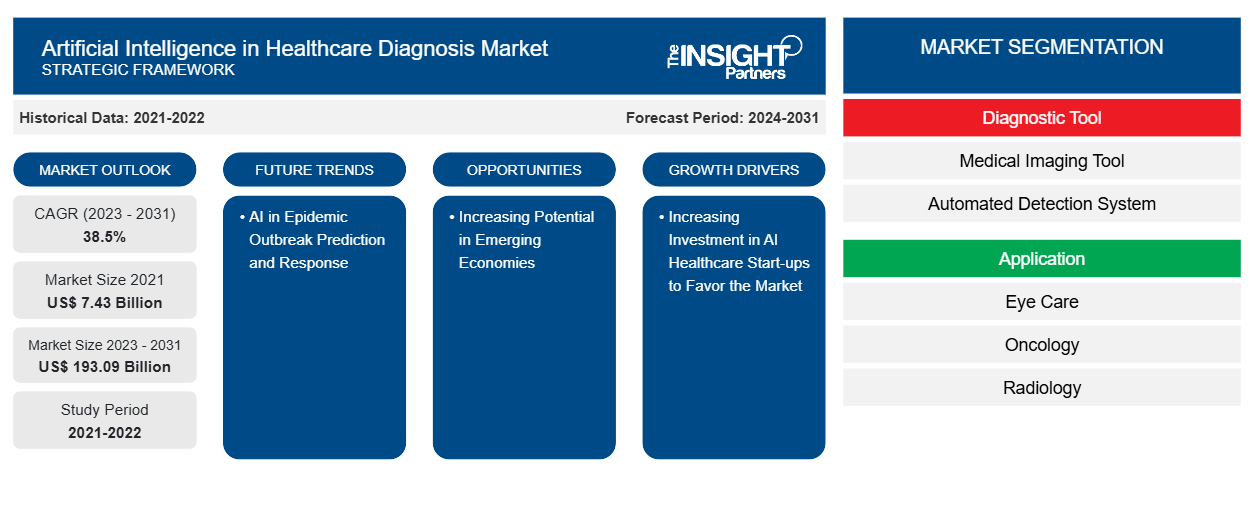预计 2021 年医疗诊断市场中的人工智能价值为 74.3 亿美元,2023 年将达到 xx 亿美元。预计到 2031 年将达到 1930.9 亿美元,到 2031 年的复合年增长率为 38.5%。人工智能成像解决方案、远程监控和远程医疗、预测分析和早期检测可能仍将是医疗诊断市场趋势中的关键人工智能。
医疗诊断人工智能市场分析
推动市场发展的关键因素包括人工智能 (AI) 在疾病诊断和识别中的日益普及以及对 AI 医疗初创企业的投资增加,这些因素预计将推动市场的增长。AI 在诊断程序中的集成正在改变诊断和患者护理行业。例如,2023 年 10 月,飞利浦与西班牙的 Quilbim 合作,提供 AI 成像和报告工具以支持磁共振 (MR) 前列腺检查。
然而,缺乏熟练的人工智能劳动力和医疗软件监管准则不明确阻碍了市场的增长。
医疗诊断人工智能市场概览
全球医疗诊断人工智能市场按地区划分为北美、欧洲、亚太、中东和非洲以及南美和中美洲。该地区的市场增长预计是由于降低医疗成本的需求不断增长以及大数据在医疗保健中的重要性等因素推动的,这些因素是推动增长的一些因素。此外,基于人工智能的工具在医疗保健中的适用性不断提高,资本投资也在增加。此外,人工智能 (AI) 在疾病诊断和识别中的应用日益广泛,对人工智能医疗初创企业的投资不断增加,这些因素正在导致预测期内的市场增长。
定制此报告以满足您的需求
您可以免费定制任何报告,包括本报告的部分内容、国家级分析、Excel 数据包,以及为初创企业和大学提供优惠和折扣
-
获取此报告的关键市场趋势。这个免费样品将包括数据分析,从市场趋势到估计和预测。
医疗诊断人工智能的市场驱动因素和机遇
增加产品发布数量以利于市场。
医疗保健领域的人工智能是迄今为止最重要的技术进步之一。医疗保健初创公司正在开发人工智能驱动的诊断和治疗解决方案,这是研究期间市场增长的主要因素。2023 年 5 月,Lumibird Medical 推出了 C.DIAG,这是一个利用人工智能 (AI) 算法的干眼诊断辅助平台。同样,2024 年 4 月,通用电气公司在 Vscan Air SL 上推出了 Caption AI 人工智能 (AI) 驱动的软件,用于在护理点进行快速心脏评估。
新兴经济体潜力不断扩大——医疗诊断市场人工智能的机遇
人工智能还可以通过提供替代方案和具有成本效益的解决方案来向最需要的人(包括偏远社区)提供服务,从而改善新兴市场基础设施薄弱的限制。利用移动网络的广泛覆盖,人工智能可用于远程医疗以进行早期疾病诊断,从而节省了维护庞大的社区卫生工作者网络的成本。癌症筛查和治疗是人工智能为有针对性的大规模干预措施提供显著影响力的领域。印度每年新增癌症病例超过 100 万例。由于印度老年人口的增加和生活方式的改变,这一数字可能还会增加。印度每年新增癌症病例超过 100 万例,而经验丰富的肿瘤病理学家却不足 2,000 名,可称为肿瘤病理学专家的病理学家不足 500 名。
因此,将人工智能融入诊断解决方案可以为新兴国家建立更具弹性和可持续性的医疗保健系统。
医疗诊断人工智能市场报告细分分析
医疗诊断市场分析中人工智能的关键贡献部分是服务和应用。
- 根据诊断工具,医疗诊断市场中的人工智能分为医学成像工具、自动检测系统等。医学成像工具部分在 2023 年占据了更大的市场份额。然而,预计在预测期内,自动检测系统将在市场上实现最高的复合年增长率。
- 市场按应用细分为眼科护理、肿瘤学、放射学、心血管和其他领域。2023 年,肿瘤学领域占据了最大的市场份额。然而,预计在预测期内,放射学领域将见证市场最快的增长率。
- 根据终端用户,医疗诊断市场的人工智能已细分为医院和诊所、诊断实验室和家庭护理。医院和诊所部分占据了最大的市场份额,而诊断实验室部分预计在预测期内将见证市场最快的增长率。
- 根据服务,医疗诊断人工智能市场细分为远程会诊、远程监控和其他服务。远程会诊部分占据了最大的市场份额,而远程监控部分预计在预测期内将实现最高的复合年增长率。
医疗诊断人工智能市场份额地域分析
医疗诊断人工智能市场报告的地理范围主要分为五个区域:北美、亚太、欧洲、中东和非洲、南美/南美和中美。
北美是医疗诊断人工智能市场最大的市场,其中美国占有最大的市场份额,其次是加拿大。美国市场的增长受到多种因素的推动,例如降低医疗成本的需求、医疗保健领域大数据的重要性日益增加以及资本投资不断增加,这些因素都推动了医疗诊断对人工智能的需求。同样,在加拿大,政府在全国范围内实施基于人工智能技术的举措不断增多,这也促进了市场的增长。
亚太地区是全球范围内医疗诊断人工智能增长最快的市场。该地区的分析基于中国、印度、日本、澳大利亚、韩国和亚太地区其他地区。由于缺乏医疗专业人员、慢性病患病率不断上升、对初创企业的投资不断增加以及该地区医疗基础设施不断改善,预计该地区将拥有多个市场增长机会。
医疗诊断人工智能市场区域洞察
Insight Partners 的分析师已详细解释了预测期内影响医疗诊断人工智能市场的区域趋势和因素。本节还讨论了医疗诊断人工智能市场的细分市场和地理位置,包括北美、欧洲、亚太地区、中东和非洲以及南美和中美洲。

- 获取医疗诊断市场人工智能的区域特定数据
医疗诊断人工智能市场报告范围
| 报告属性 | 细节 |
|---|---|
| 2021 年市场规模 | 74.3亿美元 |
| 2031 年市场规模 | 1930.9亿美元 |
| 全球复合年增长率(2023 - 2031) | 38.5% |
| 史料 | 2021-2022 |
| 预测期 | 2024-2031 |
| 涵盖的领域 |
按诊断工具
|
| 覆盖地区和国家 |
北美
|
| 市场领导者和主要公司简介 |
|
医疗诊断市场参与者密度中的人工智能:了解其对业务动态的影响
医疗诊断人工智能市场正在快速增长,这得益于终端用户需求的不断增长,而这些需求又源于消费者偏好的不断变化、技术进步以及对产品优势的认识不断提高等因素。随着需求的增加,企业正在扩大其产品范围,进行创新以满足消费者的需求,并利用新兴趋势,从而进一步推动市场增长。
市场参与者密度是指在特定市场或行业内运营的企业或公司的分布情况。它表明在给定市场空间中,相对于其规模或总市场价值,有多少竞争对手(市场参与者)存在。
在医疗诊断人工智能市场运营的主要公司有:
- 微软,
- 荷兰皇家飞利浦公司,
- 英特尔公司,
- 通用电气公司
- Alphabet Inc.,
- NVIDIA 公司,
免责声明:上面列出的公司没有按照任何特定顺序排列。

- 了解医疗诊断市场人工智能顶级关键参与者概况
医疗诊断人工智能市场新闻和最新发展
医疗诊断人工智能市场的评估是通过收集初步和二次研究后的定性和定量数据进行的,其中包括重要的公司出版物、协会数据和数据库。以下是医疗诊断人工智能市场的发展和策略列表:
- 2023 年 5 月,Digital Diagnostics 在美国东南部地区推出了其 LumineticsCore Al 诊断系统。LumineticsCore 是一款获得 FDA 批准的 De Novo 自主 AI 诊断系统(来源:公司新闻稿)
- 2021 年 12 月,F. Hoffmann-La Roche Ltd 推出了基于人工智能 (AI) 的数字病理学算法,以帮助病理学家评估乳腺癌标志物 Ki-67、ER 和 PR。(来源:公司新闻稿)
医疗诊断市场中的人工智能报告范围和交付成果
“医疗诊断人工智能市场规模和预测(2021-2031)”报告对以下领域进行了详细的市场分析:
- 范围内所有主要细分市场的全球、区域和国家层面的市场规模和预测
- 市场动态,如驱动因素、限制因素和关键机遇
- 未来主要趋势
- 详细的 PEST/波特五力分析和 SWOT 分析
- 全球和区域市场分析涵盖关键市场趋势、主要参与者、法规和最新市场发展
- 行业格局和竞争分析,涵盖市场集中度、热点图分析、知名参与者和最新发展
- 详细的公司简介
- 历史分析(2 年)、基准年、预测(7 年)及复合年增长率
- PEST和SWOT分析
- 市场规模、价值/数量 - 全球、区域、国家
- 行业和竞争格局
- Excel 数据集
近期报告
相关报告
客户评价
购买理由
- 明智的决策
- 了解市场动态
- 竞争分析
- 客户洞察
- 市场预测
- 风险规避
- 战略规划
- 投资论证
- 识别新兴市场
- 优化营销策略
- 提升运营效率
- 顺应监管趋势























 获取免费样品 - 医疗诊断市场中的人工智能
获取免费样品 - 医疗诊断市场中的人工智能